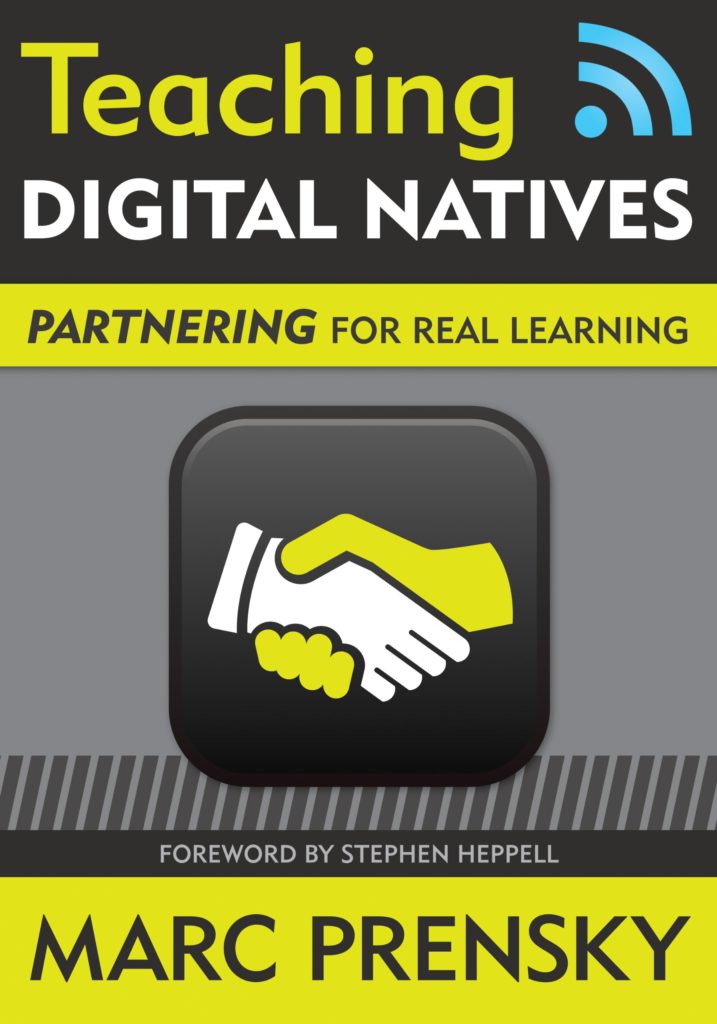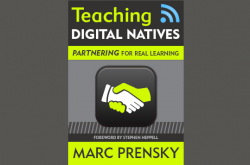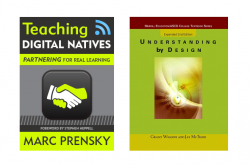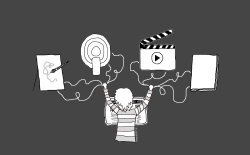
[Note: All links to this book are Amazon Affiliate links. If you click any of these and make a purchase from Amazon, we will receive a small commission at no extra cost to you. Thanks for your support!]
Some books help you improve on the things you’re already doing. Other books completely change what you do in the first place. Marc Prensky’s Teaching Digital Natives: Partnering for Real Learning is the second kind. Whether you already integrate technology into your teaching or you consider yourself tech-phobic, this book will show you how to do it right: ironically, by keeping your focus off the technology.
Here’s the book’s premise in a nutshell:
- Technology has changed our world, and will continue to change it in ways we can’t even imagine.
- To prepare our students for this world, we need to dramatically change the way we teach.
- This new way does NOT require us to learn all the technology ourselves. In fact, when it comes to technology, teachers should be as “hands-off” as possible.
Chapter Notes and Commentary
Chapter 1: Partnering: A Pedagogy for the New Educational Landscape
We are introduced to the Partnering Pedagogy: Instead of being the ones who deliver the content to the students, we take on a new role where we simply set learning goals, then coach and consult with students as they determine how to meet them.
If I’m understanding it correctly, partnering in its purest form has us say, “Here’s what you need to learn. Use whatever tools work best to learn it. Then prove to me that you learned it, using the final form of your choice.” Students can then jump online, get on their phones, talk to each other, read a textbook, conduct a survey, do whatever it takes to learn the thing, then develop some final product to demonstrate their learning – a video, a podcast, a poster, an academic paper, a website – whatever best fits the content and their interests.
This idea was jaw-dropping for me. Imagine how students would feel with all that freedom, truly learning at their own pace, and using whatever technology was available, instead of waiting for everyone to use the same tool at the same time. And the time it would free up for teachers! Less direct instruction would mean fewer lesson plans, and not nearly as much homework and grading.
Prensky points out that this approach isn’t exactly new, that it exists under different names, including problem-based or project-based learning (PBL). But while a teacher could build a lot of structure into a PBL unit, Prensky’s description of partnering seems more open-ended, which is a little scary for me. The chapter doesn’t include much research to support this method, and when I look outside the book I can’t find any, at least not using the term “partnering.” So I’m left with this question: Prensky’s description of partnering sounds great in theory, but does it actually work?
Chapter 2: Moving to the Partnering Pedagogy
This chapter offers some mental and logistical tips for making the transition to partnering, including ways to determine whether your students are ready, classroom arrangements, and a description of the different levels of partnering.
For me, the most important concept in this chapter is the principle of Nouns and Verbs. In this new pedagogy, teachers should focus on the verbs of school – the measurable cognitive tasks that have always been the aim of education, things like calculating, evaluating and communicating. What we don’t focus on are the nouns – the tools students use to practice the verbs, like online resources, gadgets, and of course, books. These will constantly change and evolve, and will continue to make learning easier, richer, and more fun, but they are not the point. The verbs are the point.
The noun/verb principle made a lot of sense to me, and it should come as a relief to teachers who are intimidated by technology, because it means we can still put most of our energy into our areas of expertise, our specific content. But here’s what I wonder: Don’t teachers need at least a basic understanding of the types of tools (e.g., document creation, presentation tools, etc.) and how they work together (e.g., that videos can be edited, uploaded and embedded) to be able to guide and supervise students using technology? I get that we don’t need to know how to use every tool, but shouldn’t we have a sort of “meta” awareness of the spectrum of tools?
Chapter 3: Think People and Passions Rather Than Classes and Content
Here we are urged to make every effort to get to know our students’ passions and allow students, whenever possible, to follow them. If we are clear about the verbs we want students to practice, we should be able to help them practice those verbs within the context of their interests. It is our job to learn what our students’ passions are and help them discover them for themselves. Prensky offers tips for how to gather, record, and use this information.
The chapter also delves into the different roles teachers and students play in a partnering relationship: The teacher works as coach, guide, and instructional expert. The student works as researcher, technology expert, thinker, world changer, and self-teacher.
For me, this chapter answered more questions than it raised. Reading it helped me get a more concrete idea of how to take some of the theoretical concepts of partnering and apply them in a real way. At this point in the reading, I’m getting hungry for case studies: I want to see these principles in action in a real school, where they are working. If you know of a teacher who is doing these things successfully and has documented them, please send them over. Otherwise, I would love to read a follow-up book from Prensky showcasing real case studies of partnering.
Chapter 4: Always Be Real (Not Just Relevant)
This chapter is best summarized in this quote: “Unlike in the past, when kids really did have to be patient and wait to grow up in order to use whatever they learned, today’s kids can experience immediate connections every day. Kids who learn to download, text, and tweet can immediately participate in profound social revolutions like crowdsourcing (and less profound ones, like voting for American Idol). Kids who learn to play almost any complex game quickly collaborate and compete with others around the globe. When they post to a blog about something they are interested in, kids are reaching a worldwide audience. By joining a Twitter campaign, they help change policy in the biggest corporations.”
The chapter goes into detail about ways teachers can make their course content real for students — connecting them to actual events happening right now — rather than just trying to make the material relevant.
My guess is that although this advice is exciting and rich with possibility, some teachers will feel intimidated by it: Doing this is going to take so much work, so much research, so much time! I already know how to teach my content; connecting it to current events will require me to prep new lessons every year. I think the best answer to this is to start small, with one unit. And partnter with your students here: Instead of putting all the responsibility on yourself for making the content real, involve students in making those connections. How do you react to the task of making content real?
Chapter 5: Planning: Content to Questions, Questions to Skills
Here we learn how to plan instruction: how to actually take our curriculum and standards and turn them into the kinds of guiding questions Prensky recommends we use to frame our units. It is here where I see this book connect with Understanding by Design, the other book we’re studying this summer, because it also takes a “backward” approach, considering what you might ask students to do in a final assessment, and working backwards from there.
I would imagine that developing these guiding questions, and making explicit connections between the questions and the curriculum, takes a lot of trial and error, because there seems to be an art to it — not going so broad that students don’t know what you’re after, but not so specific that they require no real inquiry. This makes me think that working with a small group of teachers on partnering units would be really helpful in getting this right. Again, reading real case studies would go a long way toward helping people learn how this process works.
Tell Us What You Think
I would love to hear from people who have tried partnering and seen success, from those who have tried it and had problems, and from those who are just discovering this concept — what are your questions? Tell us your stories. Marc Prensky has agreed to respond to our questions in some form — we are figuring out the date and delivery system right now — but send in your questions and there’s a good chance we’ll get them answered from the author himself.
Our next discussion of Natives, where we’ll cover chapters 6-10, will be posted on July 14. And if you’re enjoying this one, check out our other book study of Wiggins and McTighe’s Understanding by Design.
Click here to read our summary of Teaching Digital Natives, Chapters 6-10.





Good Afternoon,
I finished the 5th chapter this morning and would probably echo some of the same sentiments as you Jennifer. I annotated as I read and here it is:
1. I like the rocket analogy
2. Students should be groomed for self-sufficiency
3. I thought while I read chapter one of self-sufficiency, life-long leaners, the 4 C’s (P21), independence, flexibility and self-motivation and management.
4. I was intrigued by the levels of partnering.
5. I found myself thinking of how I have vacillated among all three.
6. What this requires is a huge paradigm shift for Ts and Ss.
7. The teacher’s paradigm shift appears more difficult (giving up power)
8. I was disagreeing adamantly and I still do about the level of technology use by the teacher. There is a parenthetical statement about modeling examples up front and think that is key to support quality products. Students can pick apart the model using a rubric or having a discussion. When I have offered choices with tools, I let them know that selecting tools for which I am unfamiliar will mean troubleshooting on your own.
9. The course I teach is a critical thinking class. I do put alot of the onus on students for making meaning of the textbook with SQ3R and the supplemental articles, readings, activities, and videos are there to enhance their understanding. I provide the open-ended questions and they make the connections, synthesize the materials, and bounce it back to the big questions for consideration.
10. Partnering requires the teacher to pull back and sometimes allowing students to “fail”. The failure becomes a tool for refinement and reflection to improve.
11. I currently use Paideia Seminar in class about 2-4 times a quarter. This is the most beneficial learning for them.
12. Partnering can be the culture of a classroom, but what happens when it is not a part of the school culture? Expectations will differ from room to room and this is confusing and frustrating for students.
13. For this reason (12), I am perceived as one of the teachers that is “doing too much”.
14. Nouns and verbs: good connection to UbD
15. Iteration is key to partnering to work. TIMELY FEEDBACK through questioning, discussion…etc.
16. Timely feedback is hard especially when it involved writing. The onus is on both me and the students.
17. Questioning is a strong point for me
18. “…Never use the technology for them.” UNCLEAR
19. World changer!! YES BIG TIME
20. I like “Relating What I am Learning to What I Like”
21. I am a big fan of Buck Institute for Ed’s Webinar Series on PBL in G+. They also have a YouTube channel that I subscribe to and as a regular part of the show artifacts and real time discussions with teachers who are implementing PBL are a highlight of the show.
As a part of a grant through YSA (Youth Service America), we approached the year thematically to work on homelessness, hunger and poverty. I will put them in a dropbox folder or a folder in G Drive and post the link later this evening.
Jennifer, thank you so much for doing this!! This is what being on Twitter and using a PLN is all about.
Aren’t we partnering now as we chime in on these posts? IJS
Shayne
#8 and #18. I get what you’re saying, and I resisted this concept, too. I think the point is that we are trying to prepare students for a world where technology use is imperative, so the more true hands-on time they have, the better. And if we don’t allow them to use a particular tool until we are adept with it ourselves, that will seriously limit what they are able to use. There are places where I think Prensky’s insistence that we never use technology (ideally) is unrealistic. When I tried a brief partnering unit last fall in a friend’s class, some students were so unskilled with technology, but I kept hearing that rule in my head about keeping my hands off the tech, and I think we wasted a lot of time waiting for some kids to “get there.” With a do-over, I would have done an assessment early on to see who was far behind with the technology and prepared a short demo. I think Prensky’s philosophy would work well once a bare minimum of tech knowledge has been reached with all students. This is why I would really like to see some real case studies — I would be more convinced of the need to follow this principle if I saw teachers and students with a variety of skill levels following it with success.
#11. Thanks for mentioning Paideia. I’m only vaguely familiar with it and now plan to look into it for a future post.
#13. I can totally see how this would happen. I’m thinking the best way for a teacher to implement something like this would be to pilot it with a small group of teachers. If that’s not possible, then it would be good to first get the support of admin to “try it,” then be really transparent with the rest of the faculty — tell them what you’re trying, admit it sounds pretty radical, invite them to observe, etc. And if that doesn’t work, then try doing it in smaller, sneakier ways until you can build enough evidence that it works.
#16. I have the same problem. It seems like partnering could make giving feedback on writing easier, only because teachers are more freed up during class time to conference with students, and because we don’t need to do as much lesson planning. I still haven’t found a way to cut back on the time it takes to grade, but I did put out a video earlier this year on using Rubric Codes that might help.
Thanks so much for your participation, Shayne. I really hope others will join us soon.
I will take a look at the video on rubric codes. I guess my only concern about feedback is the student’s ability to look critically at someone else’s work. Grooming 1st…then have them partner to peer grade/edit for give feedback.
Here is a link to the folder with some artifacts from our work on homelessness, hunger and poverty: https://www.dropbox.com/sh/b86pus874m25kcs/AABXmGRzjj1UBWrLMQKQcC5Ta
It is a combination of IB CAS and curriculum.
I have been sent a link to a fantastic article that really speaks to some of our doubts and concerns about students’ readiness for full partnering with technology. It’s definitely worth a read: The Absurd and Unfounded Myth of the Digital Native, by Enrique Dans. I would love to hear what you think of it!
Hi Jennifer, First of all I should say that I haven’t read this book by Prensky, but I just wanted to say that I’m glad you mentioned this – the other side of the digital natives debate. There is quite a large amount of research that speaks against a digital natives’ supposed inherent ability with technology. Here is a link to an article that summarizes the literature on both sides quite well:
http://ro.uow.edu.au/cgi/viewcontent.cgi?article=2465&context=edupapers
You alluded to this in your reply comment to Shayneswift on July 5, 2014 that some students are so unskilled with technology, and that’s what really bothers me about the term digital native (and also digital immigrant) – that it creates labels and unfair expectations for students and teachers. Just because someone was born at a certain time they are supposedly great with technology? How is that unskilled student going to feel when these expectations are just thrust upon him or her without any instruction or training? Aren’t we as educators unfairly setting them up for failure or at the very least unnecessary frustration? For example, assuming students can properly Google a topic to find reliable information about it just because they grew up with a computer in their house or even perform certain formatting techniques in a document or if they don’t know how they can find a source to teach them how on the Internet will only cause frustration if they can’t do it, and on top of that if they’re supposed to be skilled in this area because they’re a digital native won’t that make them even less likely to ask for help or feel embarrassed in front of their peers if they do? Similarly, why should teachers who are born at a different time assume to be poor with technology? Why should teachers assume the idea that “I’m too old to learn this?” Isn’t that sort of modeling exactly what we don’t want in classrooms? Don’t we want educators to encourage students to not fear making mistakes, and technology is a great opportunity to do just that.
Another EXCELLENT article that addresses the problems we might have with handing so much control over to our students, just published yesterday: Angela Watson’s 5 Ways to Support Kids Who Struggle with Student-Directed Learning.
Hi Jennifer, I know a wonderful science teacher who has been facilitating what he calls “passion-based learning” for several months now. The results have been truly inspiring. I know you are looking (based on your reviews in Ch. 3) for a teacher who is doing this kind of teaching successfully, so I would like to connect him with you. What’s the best way to do that?
Hey Lan! I would love to hear more about this. Use my contact form (click the “About” tab in the menu, then go to Contact) and send me an email!
Partnering is successful in our school!!! students actually work together in some cases especially when they make a project. We what we call SIOP, Kagan Cooperative Learning and it’s a great program where you actually asking questions, discussing with your student without having you to answer them.
I am not a teacher but a parent of a year 8 student, (and a medical educator) and it strikes me that although my daughter is a digital native, with the amazing skills at manipulating her computer and iphone interfaces, and ability to learn new software etc, she has almost zero experience at this stage at finding resources and canvassing broad information critically to find what she needs. I think this is analogous to going to the library and finding all the books and journal articles on a topic and then choosing the best sources and then selecting the relevant article and then using it in a meaningful way for your needs. Assuming that because she is a digital native that she knows how to find what she needs in the vastness of the internet is not true in her case. As a doctor I am fairly tech competent, but I had to learn how to do good literature searches, as opposed to just ‘googling’ subjects.
So as an example in her recent history essay about Angkor Wat, the teacher did basically what you suggest – here is the question that I want you to answer, go away and find the answer and then present it in whatever medium you prefer, podcast, interview, presentation etc. She used as her first sources the Lonely Planet website and Wikipedia. I had to remind her that her textbook had a chapter about it because she didn’t think of reading that, and then help her find decent websites for the purpose. I offered to take her to the library. I showed her online videos she could watch. But I’m having to teach her how to scope the subject. Maybe she just isn’t very self directed but I think navigating the internet for academic purposes does not necessarily come naturally to the digital native.